Usage
As the 12-pounder calibre was consistent with both the French and the British calibre systems, it was a widespread gun amongst nations between the 17th and the 19th century. From the late 18th century, the French Navy used the 12-pounder in three capacities: as main gun on early frigates under Louis XIV, on standard frigates under Louis XV and on light frigates under Louis XVI; as secondary artillery on 64-gun ships; to arm the castles of 80-gun ships of the line; and to equip the third deck of early first-rate ships.
Under Louis XIV, frigates were organised into "first-rank frigates", which were small two-deckers comparable in role to the 60-gun ships of the 19th century, and smaller "second-rank" frigates. The first-rank frigates carried the 12-pounder as main artillery on their lower deck. Later, under Louis XV, the frigate took its modern shape with a single artillery deck complemented by smaller pieces on the castles; new heavy frigates were developed to carry 26 12-pounders, with Hermione as the lead ship of the series. Hermione was captured by the British in 1757 and was swiftly imitated. A breakthrough towards fielding heavier guns was made in 1772, when the two units of the Pourvoyeuse class were built, with 24-pounders intended, but 18-pounders used in practice, and the 12-pounder remained the standard issue on most units. Under Louis XVI, the heavier 18-pounder frigate became predominant, with over 130 units produced, but the French Navy still had around 70 lighter 12-pounder frigates in commission.
On 64-gun two-deckers, the 12-gun was used as secondary artillery, to supplement the 24-pounder main batteries. 28 guns were carried on the top gun-deck.
Larger units used the 12-pounder to complement the firepower provided by their main and secondary artillery. On 80-gun ships of the Tonnant class and Bucentaure class, they armed the forecastle and the poop deck. On capital ships, the 12-pounder was used on the third deck from the reign of Louis XIV, with units like Royal Louis or Soleil Royal as typical examples. While the secondary artillery of these 100-gun ships evolved from 18-pounders to 24-pounders, the 12-pounder remained the standard gun on the third deck until 1803, when the Océan-class ship Impérial became the first 120-gun to carry 18-pounders on her third battery.
In the Royal Navy, the 12-pounder was used in a similar capacity. The capture of Hermione in 1757 encouraged the British to imitate her design, yielding the Southampton and Richmond-class frigates. The 12-pounder also equipped the castles on razeed ships, where 12 pieces were mounted, and the 22-gun secondary battery of 50-gun fourth-rates. Finally, 30 were installed on the third deck of 90-gun second-rates.

A carronade is a short, smoothbore, cast-iron cannon which was used by the Royal Navy. It was first produced by the Carron Company, an ironworks in Falkirk, Scotland, and was used from the mid-18th century to the mid-19th century. Its main function was to serve as a powerful, short-range, anti-ship and anti-crew weapon. The technology behind the carronade was greater dimensional precision, with the shot fitting more closely in the barrel, thus transmitting more of the propellant charge's energy to the projectile, allowing a lighter gun using less gunpowder to be effective.

Steam frigates and the smaller steam corvettes, steam sloops, steam gunboats and steam schooners, were steam-powered warships that were not meant to stand in the line of battle. The first such ships were paddle steamers. Later on the invention of screw propulsion enabled construction of screw-powered versions of the traditional frigates, corvettes, sloops and gunboats.

In the rating system of the Royal Navy used to categorise sailing warships, a fifth rate was the second-smallest class of warships in a hierarchical system of six "ratings" based on size and firepower.
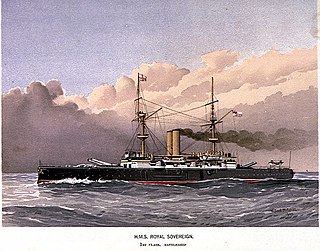
Pre-dreadnought battleships were sea-going battleships built from the mid- to late- 1880s to the early 1900s. Their designs were conceived before the appearance of HMS Dreadnought in 1906 and their classification as "pre-dreadnought" is retrospectively applied. In their day, they were simply known as "battleships" or else more rank-specific terms such as "first-class battleship" and so forth. The pre-dreadnought battleships were the pre-eminent warships of their time and replaced the ironclad battleships of the 1870s and 1880s.
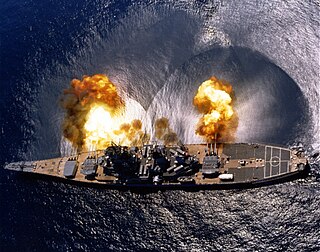
Naval artillery is artillery mounted on a warship, originally used only for naval warfare and then subsequently used for more specialized roles in surface warfare such as naval gunfire support (NGFS) and anti-aircraft warfare (AAW) engagements. The term generally refers to powder-launched projectile-firing weapons and excludes self-propelled projectiles such as torpedoes, rockets, and missiles and those simply dropped overboard such as depth charges and naval mines.

A dual-purpose gun is a naval artillery mounting designed to engage both surface and air targets.

The Gribeauval system was an artillery system introduced by Lieutenant General Jean Baptiste Vaquette de Gribeauval during the 18th century. This system revolutionized French cannons, with a new production system that allowed lighter, more uniform guns without sacrificing range. The Gribeauval system superseded the Vallière system beginning in 1765. The new guns contributed to French military victories during the French Revolutionary Wars and Napoleonic Wars. The system included improvements to cannons, howitzers, and mortars. The Year XI system partly replaced the field guns in 1803 and the Valée system completely superseded the Gribeauval system in 1829.

The 36-pounder long gun was the largest piece of artillery mounted on French warships of the Age of Sail. They were also used for Coastal defense and fortification. They largely exceeded the heaviest guns fielded by the Army, which were 24-pounder long guns. The nominal weight of shot was 36 French livres, 17.6 kg (38.8 lb).
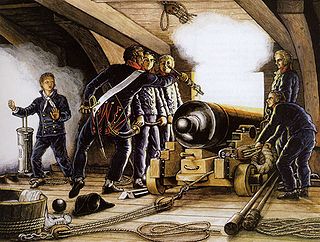
The 18-pounder long gun was an intermediary calibre piece of naval artillery mounted on warships of the Age of Sail. They were used as main guns on the most typical frigates of the early 19th century, on the second deck of third-rate ships of the line, and even on the third deck of late first-rate ships of the line.
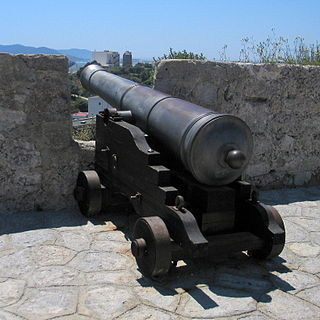
The 24-pounder long gun was a heavy calibre piece of artillery mounted on warships of the Age of Sail. 24-pounders were in service in the navies of France, Spain, Great Britain, the Netherlands, Sweden, and the United States. They were comparable to the Canon de 24 Gribeauval used by the French Army as its largest piece of siege artillery. 24-pounders were used as main guns on the heaviest frigates of the early 19th century and on fourth-rate ships of the line, on the second deck of first-rate ships of the line, and on the second deck of a few large third-rates.

The 8-pounder long gun was a light calibre piece of artillery mounted on French warships of the Age of Sail. It fired a projectile of eight livres in weight, equivalent to 8.633 English pounds, or 8 lb 10 oz. They were used as chase guns or main guns on light ships of the early 19th century, and on the quarterdeck and forecastle of ships of the line. They were similar in design to the Canon de 8 Gribeauval.

A gunport is an opening in the side of the hull of a ship, above the waterline, which allows the muzzle of artillery pieces mounted on the gun deck to fire outside. The origin of this technology is not precisely known, but can be traced back to the late 15th century, with the appearance of artillery in naval warfare. Ships featuring gunports were said to be pierced, since the ports were cut through the hull after the construction.
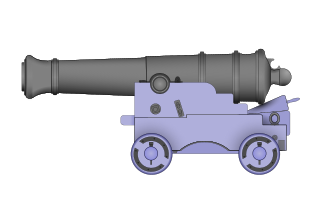
The 30-pounder long gun was a large piece of artillery mounted on French warships of the Age of Sail. They were the heaviest component of the unified system standardised on the 30-pounder calibre, replacing both the 36-pounder long guns in their usages, and even some 24-pounders.
The 30-pounder short gun was a piece of artillery mounted on French warships of the Age of sail. They were the middle-sized component of the unified system standardised on the 30-pounder calibre, replacing both the 24-pounders and 18-pounders in many usages.
A Hermione-class frigate was a type of 30-gun frigate of the French Navy, carrying a half-battery of 12-pounder long guns on the lower deck as its main armament, and a complete battery of 6-pounder guns on the upper deck. Two ships of this type were built in 1699 on plans by Blaise Pangalo. They were labelled "5th-rank frigates-ships" at the time.

The 18-pounder short gun was an intermediary calibre piece of artillery mounted on warships and merchantmen of the Age of sail. It was a lighter version of the 18-pounder long gun, compromising power and range for weight.
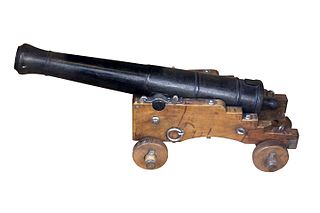
The 8-pounder short gun was a light calibre piece of artillery mounted on French warships of the Age of sail. They were used as main guns on light ships of the early 19th century, and on the quarterdeck and forecastle of ships of the line. They were similar in design to the Canon de 8 Gribeauval.

The 32-pounder guns were sets of heavy-caliber pieces of artillery mounted on warships in the last century of the Age of sail, during the 18th and early 19th centuries. It was usually the most powerful armament on a warship. The British version fired a 14.4-kilogram projectile at about 487 meters per second, for a muzzle energy of over 1.7 million joules. They were most famous being mounted on HMS Victory of the Royal Navy. Such a powerful gun with a large weight of shot posed serious damage to enemy ships.

The 64-gun ship of the line was a type of two-decker warship defined during the 18th century, named after the number of their guns. 64-guns had a lower battery of 24-pounders and an upper battery of 12-pounders. Heavier variants with 18-pounders on the upper deck also existed.



















